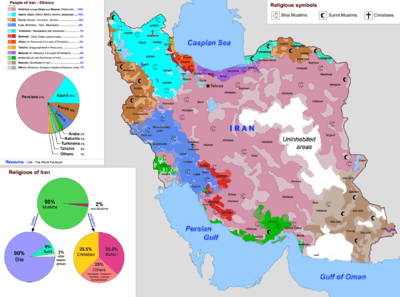Languages of Iran
- This article deals with the languages found in Iran. The Iranian languages article deals with the linguistic branch of the Indo-European languages family
| Languages of Iran (all per the CIA World Factbook) | |
|---|---|
| Official languages | Persian |
| Main languages | Persian 53%, Azerbaijani and other Turkic dialects 18% (e.g Qashqai, Turkmen), Kurdish 10%, Gilaki and Mazandarani 7%, Luri 6%, Arabic 2%, Balochi 2%, and other languages (Tati, Talysh, Armenian, Georgian, Neo-Aramaic, Circassian, Hebrew) 1%[1] |
| Minority languages | Armenian, Georgian, Circassian, Assyrian, and Hebrew |
| Sign languages | Persian Sign Language |
| Common keyboard layouts |
|

Different publications have reported different statistics for the languages of Iran. There have been some limited censuses taken in Iran in 2001, 1991, 1986 and 1949-1954.[2] The following are the languages with the greatest number of speakers (data from the CIA World Factbook):[3]
Classification categories of the spoken languages:
- Indo-European (Iranic mainly, smaller amounts of other branches represented mainly by Armenian, amongst others)
- Turkic (the majority being Azerbaijani, with smaller amounts of Turkmen, Qashqai, and Afshar)
- Semitic (mainly Arabic, but also Neo-Aramaic, Hebrew, and Mandean)
- Caucasian languages (such as Kartvelian, and Circassian)
CIA World Factbook
The following are the languages with the greatest number of speakers (data from the CIA World Factbook):[3]
- Persian 53%
- Azerbaijani and other Turkic dialects 18%
- Kurdish 10%
- Gilaki and Mazandarani 7%
- Luri 6%
- Arabic 2%
- Balochi 2%
- Other languages comprise 1%, and include Tati, Talysh, Georgian, Armenian, Circassian, Assyrian, Hebrew, etc.
- Total population 75,149,669 (2012 census)[4]
Census in the 1990s
A census taken in the Iranian month of Mordad (July 21 – August 21) in 1991. In this census, all 49,588 mothers who gave birth in the country, were issued birth certificates. They were asked about their mother-tongue.[5] which were : 46.2% (Persian), 20.6% (Azerbaijani), 10% Kurdish, 8.9% Luri, 7.2% Gilaki and Mazandarani, 3.5% Arabic, 2.7% Baluchi, 0.6% Turkmen, 0.1% Armenian, and 0.2% Others (e.g Circassian, Georgian, etc.). The local dialect of Arabic spoken in Iran is Khuzestani Arabic, an Iraqi Arabic dialect, but the varieties of Arabic taught across Iran to students in secondary schools, regardless of their ethnic or linguistic background, are Modern Standard Arabic and Classical Arabic, the latter a liturgical language of Islam.
Recent survey
A recent survey by the US-based organization "Terror Free Tomorrow" with error is +/- 3.1 percent margin and uniform sampling based on provincial populations mentions the breakdown as following:[6]
- Persian 50.5%
- Azeri 21.6%
- Kurd 7.6%
- Gilaki and Mazandarani 6.9%
- Lur 6.9%
- Arab 2.7%
- Baloch 1.4%
- Tati and Talysh 1%
- Turkmen 0.9%
- Other 1.2% (incl. Armenian, Georgian, Circassian, Assyrian Neo-Aramaic and other Assyrian dialects, Hebrew, Mandaic)
- Unknown/refused about 0.5%
In 1986, there was also a nationwide census done. See: (Farhad Nu’mani, Sohrab Behdad, Class and Labor in Iran: Did the Revolution Matter?, Published 2006, Syracuse University Press, 2006)[7] on the percentage of Iranians that know Persian, those who do not know and those who know it fluently.
Other estimations
In 1986, there was also a nationwide census done. See: (Farhad Nu’mani, Sohrab Behdad, Class and Labor in Iran: Did the Revolution Matter?, Published 2006, Syracuse University Press, 2006)[7] on the percentage of Iranians that known Persian, those who do not know and those who know it fluently.
According to the Kurdish-Belgian-American scholar Mehrdad Izady, whose work can be found at Columbia University School of International and Public Affairs, Gulf 2000 Project website,[8] the Iranian census of 2001 mentions that 68% of the population speaks Persian as a first language,[9] while he himself gives the following figures for 2014:
- Persian to include Luri and Bakhtiari 62.1%
- Azerbaijani 13.6%
- Kurdish 7%
- Gilaki 3%
- Mazandarani 2.8%
- Balochi 2.4%
- Arabic 1.6%
- Tourki 1.6%
- Qashqai 1.2%
- Tati 1.1%
- Raji 1%
- Turkmeni 0.9%
- [Talysh language|Talysh]] 0.4%
- Other languages include Turkmen, Armenian, Georgian, Circassian, Syriac, Qashqai, Russian, Hebrew, Raji, Minabi, as well as other Western Iranian languages (Lari etc.)
See also
References
- ↑ United States, CIA World Factbook.
- ↑ Iran. rtish. Sitād-i Artish. Dāyirah-i Jughrāfiyāʾī. Title: Farhang-i jughrāfiyāʾī-i Irān : ābādīhā. Imprint: [Tihrān] : Dāyirah-i Jughrafiyāʾī-i Sitād-i Artish, 1328-1332 [1949-54] Description: 10 v. : illus., maps (part fold. col.) Notes: Vols. 1-9 compiled under the general editorship of Hossein ʻAlī Razmārā. See for summary: (Ehsan Hooshmand, “Faslnaameyeh Goftegoo”, “A closer look at religious and ethnic statistics in modern Iran”, 2005, Tehran) The article can be found here: http://www.magiran.com/magtoc.asp?mgID=1929&Number=43&Appendix=0
- 1 2 CIA World Factbook
- ↑ "Iran – کاهش غیرمنتظره نرخ رشد جمعیت در ایران". DW Persian. Retrieved 19 July 2012.
- ↑ "در مرداد 1370، هنگام صدور شناسنامه براي نوزادان، درباره زبان ٤٩ هزار و ٥٥٨ مادر در سطح كشور سوال مطرح شد كه نتيجه حاكي از سهم حضور ٥٣٬٨ درصدي زبان هاى غيرفارسي در ايران بود. بر اساس نمونه گيري مذكور، توزيع سهم هر يك از زبان ها (به درصد) به اين شرح بود: ٤٦٬٢ فارسي؛ ٢٠٬٦ تركي آذربايجاني؛ ١٠ كردي؛ ٨٬٩ لري؛ ٧٬٢ درصد گيلكي و شمالي؛ ٣٬٥ عربي ؛ ٢٬٧ بلوچي؛ ٠٬٦ تركمني؛ ٠٬١ ارمني؛ و ٠٬٢ ساير زبان ها ". Source: زنجاني، حبيب الله، محمد ميرزايي، كامل شاپور و امير هوشنگ مهريار، جمعيت،توسعه، بهداشت باروري، چاپ دوم، تهران، نشر و تبليغ بشري، 1379. Zanjani, H.,Mirzai,M.,Shapur, K., Mehriyar, A.H., “Population, Growth, Mortality Rate”, Second Edition, Tehran, Tabligh-e-Bashari Publishers, 2000.
- ↑
- 1 2 (Farhad Nu’mani, Sohrab Behdad, Class and Labor in Iran: Did the Revolution Matter?, Published 2006, Syracuse University Press, 2006)
- ↑ http://gulf2000.columbia.edu/maps.shtml - language map of Iran
- ↑ Mehrdad Izady (2006-2011)